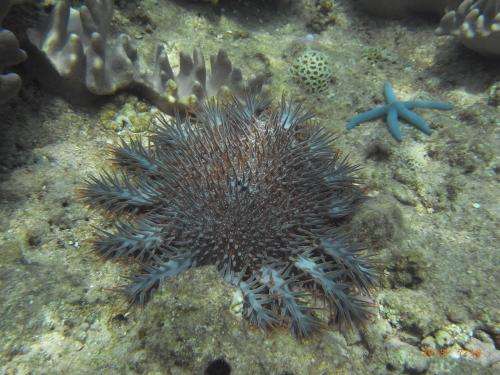Helping local fishermen fight off the crown-of-thorns starfish

New research has been published in Marine Biology on the long term population dynamics of the Crown-of- Thorns starfish, Acanthaster planci. It is one of the most long term and extensive surveys of its kind, with data spanning over 24 years through cooperation with the local fishing population of Onna Village in Okinawa and the Okinawa Institute of Science and Technology Graduate University. With fisherman providing a great deal of logistics support and data, OIST researchers have been able to plot with a high degree of accuracy the movement and population size over time of A. planci. Masako Nakamura, a researcher at OIST's Marine Biophysics Unit has headed up the joint effort.
The Crown-of-Thorns starfish is an aggressive predator of scleractinian, or hard corals, which are responsible for building coral reefs. While individuals are typically harmless, their population increase poses significant danger because they are capable of consuming large areas of coral colonies. Outbreaks in their population can potentially devastate entire reef habitats. Such habitats are important as key tourism sites for the Ryukyu Islands. Due to chronically high populations of A. planci on Japanese coral reefs, the Okinawa local government has been subsidizing population control programs since the early 1970's. Early removal efforts by fishermen who collected individuals from the reef one by one were largely ineffective due to the inability to collect on a large enough scale. Sporadic recovery of coral has often been met with more predation from additional outbreaks in A. planci population.
While population control efforts have met with mixed success, collection data on A. planci in the Onna area have been maintained continually with greater degrees of information as time has progressed. Starting in 1989 the collection area was recorded along with the number of starfish removed. From 2003, starfish were then sorted into seven different size classes. These records have been kept regularly and reliably, allowing for an analysis of the population size and dynamics over time. When examining the data for the Onna coast region, A. planci populations have been chronically observed. This is unusual compared to other regions with coral reefs which report much higher disparities during years with high and low population densities.
The study not only analyzes the population dynamics of A. planci over time, but also examines the potential factors that might be sustaining such populations off of the Onna village coast which was divided into five areas for collection. The effects of seawater temperature, number of typhoons, and rainfall, which can cause nutrient run off into the waters off the coast, were all looked at as potentially contributing to the sustained population. Data was gathered between July and August which is thought to be the peak time for larval dispersal of A. planci.
While there appears to be no significant correlation between these factors and the chronically high population rates, the study found that the majority of individuals caught off of the Onna village coast fit within a certain size and age range which suggests that there is a relatively steady number of new recruits coming in from elsewhere as well as locally. The recruitment rate refers to the number of new starfish coming into an area as larvae or juveniles. The collection data also points to a northern progression in the population densities along the Onna village coastline.
Further research is currently being conducted into ocean current movements in the area and other environmental factors which might be the cause of continuous recruitment. The hope is that this research will provide the foundation for a better understanding of how and where population outbreaks of A. planci occur. Nakamura elaborates, "This research is a first step. Now we are doing more detailed research to help conservation efforts. But we could not have done as much as we have without the help of the local fisherman who know the sea here better than anyone."
More information: "Spatial and temporal population dynamics of the crown-of-thorns starfish, Acanthaster planci, over a 24-year period along the central west coast of Okinawa Island, Japan." Marine Biology, August 2014. link.springer.com/article/10.1 … 07/s00227-014-2524-5
Journal information: Marine Biology
Provided by Okinawa Institute of Science and Technology

















